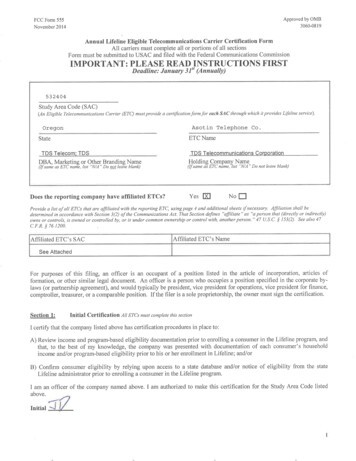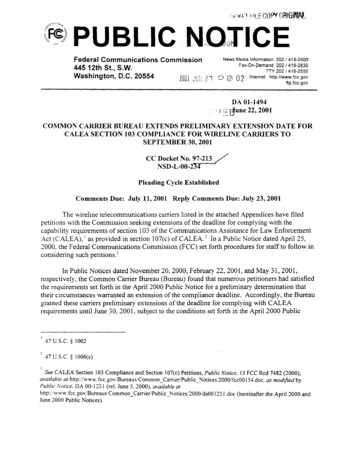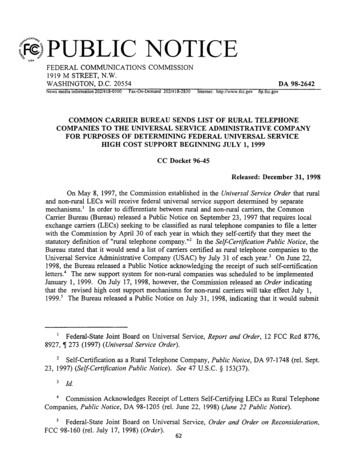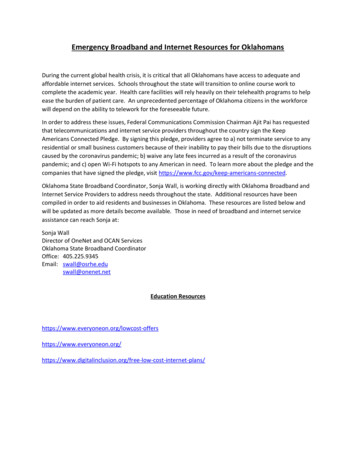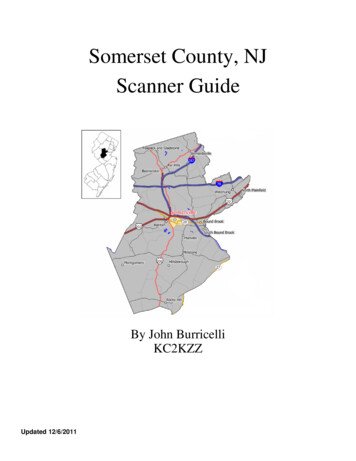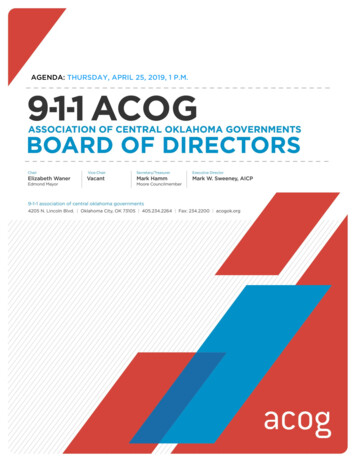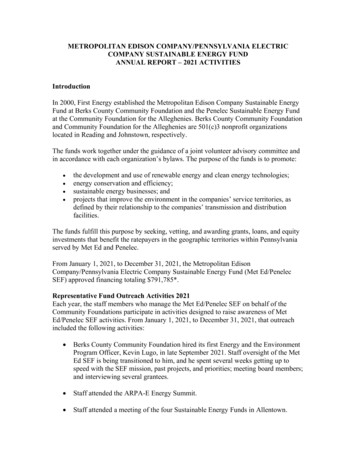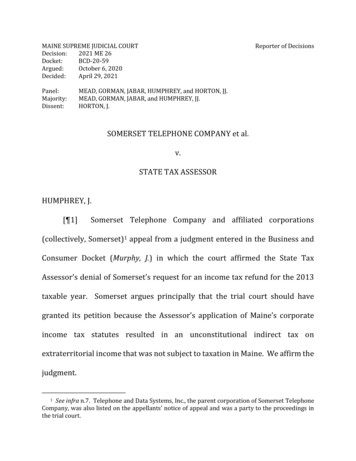
Transcription
MAINE SUPREME JUDICIAL COURTDecision:2021 ME 26Docket:BCD-20-59Argued:October 6, 2020Decided:April 29, 2021Panel:Majority:Dissent:Reporter of DecisionsMEAD, GORMAN, JABAR, HUMPHREY, and HORTON, JJ.MEAD, GORMAN, JABAR, and HUMPHREY, JJ.HORTON, J.SOMERSET TELEPHONE COMPANY et al.v.STATE TAX ASSESSORHUMPHREY, J.[¶1]Somerset Telephone Company and affiliated corporations(collectively, Somerset)1 appeal from a judgment entered in the Business andConsumer Docket (Murphy, J.) in which the court affirmed the State TaxAssessor’s denial of Somerset’s request for an income tax refund for the 2013taxable year. Somerset argues principally that the trial court should havegranted its petition because the Assessor’s application of Maine’s corporateincome tax statutes resulted in an unconstitutional indirect tax onextraterritorial income that was not subject to taxation in Maine. We affirm thejudgment.See infra n.7. Telephone and Data Systems, Inc., the parent corporation of Somerset TelephoneCompany, was also listed on the appellants’ notice of appeal and was a party to the proceedings inthe trial court.1
2I. BACKGROUNDA.Legal Background[¶2] A brief review of some of the relevant legal concepts and statutorydefinitions is helpful in understanding the factual and procedural backgroundin this case. Beginning broadly, pursuant to the Due Process and CommerceClauses of the United States Constitution, “[a]s a general principle, a [s]tate maynot tax value earned outside its borders.”2 ASARCO Inc. v. Idaho State TaxComm’n, 458 U.S. 307, 315 (1982); see U.S. Const. amend. XIV, § 1; U.S. Const.art. I, § 8, cl. 3; Container Corp. of Am. v. Franchise Tax Bd., 463 U.S. 159, 164(1983).State governments may constitutionally tax—on an apportionedbasis—the income of a business operating in multiple states if the businessactivity that generated the income is properly characterized as part of a“unitary business.” Container Corp., 463 U.S. at 165-70; see Exxon Corp. v. Dep’tof Revenue, 447 U.S. 207, 223-24 (1980); Mobil Oil Corp. v. Comm’r of Taxes,445 U.S. 425, 436-39 (1980); Gannett Co. v. State Tax Assessor, 2008 ME 171,¶¶ 11-12, 959 A.2d 741. Put another way, “[i]f a company is a unitary business,This constitutional limitation “derives from the virtually axiomatic proposition that the exerciseof a state’s tax power over a taxpayer’s activities is justified by the protection, opportunities, andbenefits the state confers upon those activities. If the state lacks a minimum connection or definitelink with the taxpayer’s activities, and thus with the property, income, or gross receipts related tothose activities, it has not given anything for which it can ask return.” 1 Jerome R. Hellerstein et al.,State Taxation § 8.07[1] at 8-72 (3d ed. 2000) (footnote omitted) (quotation marks omitted).2
3then a [s]tate may apply an apportionment formula to the taxpayer’s totalincome in order to obtain a rough approximation of the corporate income thatis reasonably related to the activities conducted within the taxing [s]tate.”Exxon Corp., 447 U.S. at 223 (quotation marks omitted); see Gannett Co., 2008ME 171, ¶¶ 12, 17, 959 A.2d 741; Irving Pulp & Paper, Ltd. v. State Tax Assessor,2005 ME 96, ¶ 6, 879 A.2d 15. “[T]he linchpin of apportionability in the field ofstate income taxation is the unitary-business principle.”Mobil Oil Corp.,445 U.S. at 439.[¶3]Likemany mula apportionment approach” to quantify unitary businessincome and identify the portion of that income that is fairly taxable by Maine.Gannett Co., 2008 ME 171, ¶ 12, 959 A.2d 741. “The ‘hallmarks’ of a unitarybusiness relationship are ‘functional integration, centralized management, andeconomies of scale.’” Id. ¶ 13 (quoting MeadWestvaco Corp. v. Ill. Dep’t ofRevenue, 553 U.S. 16, 30 (2008)); see State Tax Assessor v. Kraft Foods Grp., 2020ME 81, ¶ 42, 235 A.3d 837. Indeed, “unitary business” is defined by Mainestatute as “a business activity which is characterized by unity of ownership,functional integration, centralization of management and economies of scale.”36 M.R.S. § 5102(10-A) (2021). The term “unitary group,” which is not definedby statute, refers to a group of corporations whose members are engaged
4together in a unitary business. See Fairchild Semiconductor Corp. v. State TaxAssessor, 1999 ME 170, ¶ 2 & n.4, 740 A.2d 584; Great N. Nekoosa Corp. v. StateTax Assessor, 675 A.2d 963, 964 (Me. 1996).[¶4] Maine’s corporate income tax is imposed by a statute that provided,during the years at issue in this case, that “[a] tax is imposed for each taxableyear . . . on each taxable corporation and on each group of corporations thatderives income from a unitary business carried on by 2 or more members of anaffiliated group.”3 36 M.R.S. § 5200(1) (2011).4 As we have stated, therefore,“If a group of corporations meets the definition of a unitary business, . . . [it is]taxed as a single business pursuant to Maine law.” Fairchild SemiconductorCorp., 1999 ME 170, ¶ 2 n.3, 740 A.2d 584 (quotation marks omitted) (citing36 M.R.S.A. § 5200 (1990)). For “taxable corporations that derive income froma unitary business carried on by 2 or more members of an affiliated group withbusiness activity that is taxable both within and without [Maine], ‘income’An “affiliated group” is “a group of 2 or more corporations in which more than 50% of the votingstock of each member corporation is directly or indirectly owned by a common owner or owners,either corporate or noncorporate, or by one or more of the member corporations.” 36 M.R.S.§ 5102(1-B) (2021).3Title 36 M.R.S. § 5200(1) has since been amended but not in a way that affects our analysis inthis case. See P.L. 2017, ch. 474, § E-1 (emergency, effective Sept. 12, 2018) (codified at 36 M.R.S.§ 5200(1) (2021)).4
5means the net income of the entire group.” 36 M.R.S. § 5200(4) (2011).5 “Mainenet income,” in turn, “means, for any taxable year for any corporate taxpayer,the taxable income of that taxpayer for that taxable year under the laws of theUnited States as modified by” statutory additions and subtractions andapportionable pursuant to Maine statutes. 36 M.R.S. § 5102(8) (2011);6 see also36 M.R.S. § 5200(5) (2021). Thus, for purposes of Maine corporate taxation,“net income” is the federal taxable income for the tax year as modified andapportioned pursuant to Maine’s statutes. Id. §§ 5102(8), 5200(5).[¶5] One of the statutory modifications that must be made to a unitarygroup’s federal taxable income is a subtraction of any income that Maine cannotconstitutionally tax, 36 M.R.S. § 5200-A(2)(F) (2021), which includes“nonunitary” income—income from sources outside the group’s unitarybusiness activity, see, e.g., Gannett Co., 2008 ME 171, ¶ 17, 959 A.2d 741. Afterthis and any other modifications to the unitary group’s federal taxable income,the statutory apportionment formula is applied to the group’s modified federaltaxable income to calculate “Maine net income,” the portion of the group’sTitle 36 M.R.S. § 5200(4) has since been amended but not in a way that affects our analysis inthis case. See P.L. 2017, ch. 474, § E-3 (emergency, effective Sept. 12, 2018) (codified at 36 M.R.S.§ 5200(4) (2021)).5Title 36 M.R.S. § 5102(8) has since been amended but not in a way that affects our analysis inthis case. See P.L. 2015, ch. 300, § A-38 (effective Oct. 15, 2015) (codified at 36 M.R.S. § 5102(8)(2021)).6
6unitary income that is “apportionable to” Maine and subject to Maine corporateincome tax. 36 M.R.S. § 5102(8) (emphasis added); see also id. § 5200(5).B.Facts and Procedural History[¶6] The facts that follow are drawn from the parties’ stipulations.See Kraft Foods Grp., 2020 ME 81, ¶¶ 2, 13, 235 A.3d 837. Somerset TelephoneCompany is a small landline telecommunications company located in NorthAnson. During the 2012 and 2013 tax years, Somerset Telephone Company andabout 180 other corporations were members of a unitary group known as theTDS Group. All of the TDS Group’s members were engaged together in a unitarybusiness, although only some of them—Somerset, the affiliated taxpayer groupat issue here—conducted business activity in Maine.7 Income earned by theTDS Group’s unitary business—unitary income—was generated both withinand outside Maine. Some TDS Group members also earned income fromsources separate from the unitary business.8 This nonunitary income was7 This subset includes Somerset Telephone Company; it does not include Telephone and DataSystems, Inc. The taxpayer entity listed on the Maine tax returns included in the stipulated record is“SOMERSET TELEPHONE CO & AFFIL.” The record indicates that more than twenty TDS Groupmembers conducted business activity in Maine during the tax years at issue, 2012 and 2013, and thatfor those tax years, a single Maine return, including an attached “combined report,” was filed onbehalf of all of these Maine-nexus TDS Group members. See 36 M.R.S. §§ 5220(5), 5244 (2021);18-125 C.M.R. ch. 810, §§ .02, .05 (effective Sept. 12, 2010). The Assessor does not dispute that all ofthe Maine-nexus TDS Group members were members of the affiliated group and engaged in theunitary business. See 36 M.R.S. § 5220(5).The parties agree that—unlike in Fairchild Semiconductor Corp.—the corporations that earnednonunitary income were members of the TDS Group, the unitary group at issue here. See FairchildSemiconductor Corp. v. State Tax Assessor, 1999 ME 170, ¶¶ 2-3, 740 A.2d 584.8
7derived entirely from business activities occurring outside Maine and was notsubject to Maine taxation.[¶7] In the 2012 tax year, the TDS Group had no unitary income—itsunitary business experienced a loss of approximately 131 million. However,the nonunitary income earned by its members amounted to approximately 149 million. The TDS Group’s federal taxable income, which netted thegroup’s unitary loss against its nonunitary income, was therefore a positivenumber—approximately 18 million. See 26 U.S.C.S. § 63(a) (LEXIS throughPub. L. No. 116-282).[¶8] In October 2013, Somerset, the subset of TDS Group members thatconducted business in Maine during 2012 and 2013, filed a 2012 Mainecorporate income tax return. The return first listed the TDS Group’s federaltaxable income of approximately 18 million. Various modifications in the formof additions and subtractions were then applied to that figure pursuant to36 M.R.S. § 5200-A (2011).9 One of the modifications—the subtraction of 149million representing the nonunitary income received by TDS Group membersin 2012—was applied pursuant to 36 M.R.S. § 5200-A(2)(F). The modifications9 Portions of 36 M.R.S. § 5200-A have since been amended but not in ways relevant to the issuesin this appeal. See, e.g., P.L. 2019, ch. 659, § I-2 (effective June 16, 2020) (codified at 36 M.R.S.§ 5200-A(2)(AA) (2021); P.L. 2019, ch. 527, §§ A-3, A-4 (effective Sept. 19, 2019) (codified at36 M.R.S. § 5200-A(2)(AA), (FF) (2021)).
8resulted in “adjusted federal taxable income” of approximately negative 162million, and thus Somerset had no Maine corporate income tax liability for the2012 tax year.[¶9] Before filing its Maine corporate income tax return for the 2013 taxyear, Somerset sought a ruling from Maine Revenue Services permitting it to“carry forward,” as a deduction from the TDS Group’s 2013 federal taxableincome, the 131 million unitary business loss that the TDS Group realized in2012. Somerset argued that if the TDS Group had hypothetically not receivedany nonunitary income in 2012, it would have been entitled to take a netoperating loss carryforward deduction in 2013,10 and that disallowing thededuction would therefore increase Somerset’s 2013 Maine tax liability due tothe TDS Group’s receipt of extraterritorial nonunitary income in 2012.Somerset proposed accounting for the 2012 unitary loss by subtracting 131million from its 2013 federal taxable income for Maine either as a net losscarryforward deduction or as a modification pursuant to 36 M.R.S.The Internal Revenue Code permits deduction of net operating losses as part of the calculationof “taxable income,” 26 U.S.C.S. §§ 63(a), 172(a)-(c) (LEXIS through Pub. L. No. 116-259), and defines“net operating loss” as “the excess of the deductions allowed . . . over the gross income,” 26 U.S.C.S.§ 172(c). “In other words, if, after all allowable deductions are taken in a given tax year, a taxpayerends up with a negative number, that figure is a ‘net operating loss’ that can be carried over or backto other tax years and used as a deduction in those other tax years pursuant to section 172 of theInternal Revenue Code.” Fairchild Semiconductor Corp., 1999 ME 170, ¶ 1 n.2, 740 A.2d 584.10
9§ 5200-A(2)(F). The Assessor, in a nonbinding advisory ruling, rejected bothalternatives. See 5 M.R.S. § 9001 (2021).[¶10] In compliance with the advisory ruling, Somerset filed its 2013Maine tax return showing positive Maine taxable income and a state income taxliability. It later filed an amended 2013 return on which it listed an adjustedfederal taxable income that had been reduced by the TDS Group’s 2012 131million net operating loss, resulting in a decreased (but still positive) Mainetaxable income and decreased tax liability. Somerset requested a partial refundto account for the difference. The Assessor denied the refund claim andSomerset’s subsequent request for reconsideration.[¶11] In April 2017, Somerset filed a five-count petition for review andde novo determination in the Superior Court (Kennebec County).11 See 5 M.R.S.§§ 11001(1), 11002 (2021); 36 M.R.S. § 151(2)(E)-(G) (2021); M.R. Civ. P. 80C.After the matter was transferred to the Business and Consumer Docket, theparties filed exhibits and statements of stipulated facts and, later, a correctedstipulation of certain facts. Somerset moved for a summary judgment, and theIn Count 1, Somerset alleged that the Assessor’s decision ran contrary to the language of Maine’scorporate income tax statutes; in Counts 2 and 3, it alleged that the decision resulted in a tax schemethat violated the United States and Maine Constitutions. Somerset has not invoked the MaineConstitution on appeal. In Counts 4 and 5, Somerset sought relief in the form of alternativeapportionment, see, e.g., State Tax Assessor v. Kraft Foods Grp., Inc., 2020 ME 81, ¶¶ 1 n.2, 14-15, 235A.3d 837, but on appeal it has not challenged the trial court’s judgment in the Assessor’s favor onthose counts.11
10Assessor opposed the motion. The trial court held a nontestimonial hearingand issued an order denying Somerset’s motion for summary judgment. Basedon the parties’ agreement that no factual or legal issues remained foradjudication, the court entered a final judgment in the Assessor’s favor.Somerset timely appealed from the judgment. See 14 M.R.S. § 1851 (2021); M.R.App. P. 2B(c)(1). After oral argument, we requested supplemental memoranda,which the parties supplied.II. DISCUSSION[¶12] Because the trial court’s review of the Assessor’s decision wasde novo, see 36 M.R.S. § 151(2)(G), we review the court’s interpretation of theapplicable statutes and constitutional provisions directly, without deference tothe Assessor’s legal determinations, Kraft Foods Grp., 2020 ME 81, ¶ 13, 235A.3d 837. We review questions of constitutional and statutory interpretationde novo. Goggin v. State Tax Assessor, 2018 ME 111, ¶ 20, 191 A.3d 341(constitutional provisions); Irving Pulp & Paper, Ltd., 2005 ME 96, ¶ 8, 879 A.2d15 (statutes).[¶13] To address the question at issue on appeal, we review (A) whetherthe deduction of a hypothetical federal net operating loss is authorized byMaine’s statutes and (B) whether the Constitution demands that such a netoperating loss be allowed.
11A.Statutory Interpretation[¶14] We construe Maine’s tax statutes based on their plain language “toeffectuate the intent of the Legislature,” considering “the language in thecontext of the whole statutory scheme.” Eagle Rental, Inc. v. State Tax Assessor,2013 ME 48, ¶ 11, 65 A.3d 1278 (quotation marks omitted). As summarizedabove, Maine uses federal taxable income as a starting point for calculating theincome that is taxable in Maine. See 36 M.R.S. §§ 5102(8), 5200(5). TheLegislature did not, by beginning with federal taxable income, adopt andincorporate theoretical federal loss carryover deductions that are at odds withexplicit statutory language in Maine establishing a tax based on the federaltaxable income of the taxpayer for a taxable year. See id. § 5102(8).[¶15]Although in federal taxation, “a taxpayer may carry its netoperating loss either backward to past tax years or forward to future tax yearsin order to set off its lean years against its lush years, and to strike somethinglike an average taxable income computed over a period longer than one year,”United Dominion Indus. v. United States, 532 U.S. 822, 825 (2001) (quotationmarks omitted), no such provision was made in the Maine statutes that appliedto the tax years at issue here. In Maine at the relevant time, a corporation wastaxed on its “Maine net income,” meaning the federal taxable income “for thattaxable year . . . as modified by section 5200-A and apportionable to this State
12under chapter 821 [36 M.R.S. §§ 5210-5212 (2011)12].” 36 M.R.S. § 5102(8)(emphasis added); see also id. § 5200(5). “To the extent that it derives from aunitary business carried on by 2 or more members of an affiliated group, theMaine net income of a corporation is determined by apportioning that part ofthe federal taxable income of the entire group that derives from the unitarybusiness.” Id. § 5102(8).[¶16] Section 5200-A prescribes several additions and subtractions asmodifications to the taxable income of the taxpayer for the tax year.See 36 M.R.S. § 5200-A. Pertinent here, any nonunitary income realized duringthe taxable year is subtracted from the federal taxable income as “[i]ncome thisState is prohibited from taxing under the Constitution of Maine or the UnitedStates Constitution to the extent that it is included in the taxpayer’s federaltaxable income.” 36 M.R.S. § 5200-A(2)(F). Only limited subtractions relatedto net operating losses were allowed pursuant to Maine’s statute governingmodifications, and those subtractions did not apply for purposes of the taxationat issue here. See, e.g., id. § 5200-A(1)(H), (2)(H).[¶17] After the additions and subtractions are made, “[i]n order todetermine the portion of a unitary group’s income that is properly taxable byThese statutes have since been amended or repealed, though the statutes in chapter 821 stillrequire apportionment. See P.L. 2019, ch. 401, §§ C-9, C-10 (effective Sept. 19, 2019) (codified at36 M.R.S. §§ 5210-5211 (2021)).12
13Maine when the group has non-Maine source income, the Maine Tax Coderequires that the apportionment formula be applied to the federal taxableincome of the entire unitary group as a single entity.” Fairchild SemiconductorCorp., 1999 ME 170, ¶ 10, 740 A.2d 584; see 36 M.R.S. § 5211.13[¶18] Considering these statutes together, although Maine relies on afederal taxable income figure as a starting point for the calculation of thetaxable income in Maine for a tax year, Maine’s statutes express no purpose orrequirement that the Tax Assessor look behind a taxpayer’s federal taxableincome in other tax years to determine whether a carryforward or carrybackshould be permitted for the tax year in question. Somerset’s argument thatMaine is indirectly taxing nonunitary income is based primarily on a UnitedStates Supreme Court opinion in which, unlike the circumstances here, thetaxpayer challenged a statute affecting a deduction from income receivedwithin a tax year. Hunt-Wesson, Inc. v. Franchise Tax Bd., 528 U.S. 458, 460-63(2000). Specifically, the Supreme Court reviewed a California statute that13As the apportionment statute provided, and still provides,Any taxpayer, other than a resident individual, estate, or trust, having income frombusiness activity which is taxable both within and without this State, other than therendering of purely personal services by an individual, shall apportion his net incomeas provided in this section. Any taxpayer having income solely from business activitytaxable within this State shall apportion his entire net income to this State.36 M.R.S. § 5211(1) (2011); 36 M.R.S. § 5211(1) (2021).
14permitted a deduction of interest expenses from gross income only to theextent that the expenses exceeded the taxpayer’s nonunitary income within thetax year. Id.[¶19] In contrast, here the taxpayer is seeking an income modificationbased on a loss taken on its federal return in another tax year. The group wasnot eligible for a net operating loss carryforward on its 2013 federal tax returnbecause it had already accounted for the loss in calculating its federal taxableincome in 2012. Whether Somerset was eligible for a carryforward in Maine onits 2013 tax return must be determined by the application of Maine statutesgoverning income modifications and apportionment, see 36 M.R.S. §§ 5200-A,5211, based on the actual figures reported for the year 2013, beginning withthe amount of the TDS Group’s federal taxable income for that year. To createa hypothetical scenario in which the TDS Group did not have any nonunitaryincome in 2012 and therefore the amount of the federal taxable income for2013 would have been different, as Somerset urges us to do so, does notcomport with the plain mandates of Maine’s statutory scheme.[¶20] No statute was in place that required or allowed any addition orsubtraction of a carryover that could have been taken if the unitary groupsubject to federal taxation had received only unitary income—for instance, ifits members had reorganized themselves such that all nonunitary business was
15conducted by separate, nonmember entities. When the Maine Legislature hasaddressed net operating loss carryforwards through the statute governingmodifications, it has done so explicitly; for instance, as to the tax years 2009,2010, and 2011, the Legislature required the amount of the federal losscarryforward to be added to the federal taxable income for purposes ofcalculating Maine net income for those years. See 36 M.R.S. § 5200-A(1)(V).Any losses carried forward to 2009, 2010, or 2011 could then, in certaincircumstances, be deducted in Maine beginning in 2012.See 36 M.R.S.§ 5200-A(2)(H). The Maine statutes governing modification that were in effectfor the 2012 and 2013 tax years did not require or permit any addition orsubtraction based on the taxpayer’s federal taxable income for other taxableyears.[¶21] Although in Fairchild Semiconductor, 1999 ME 170, 740 A.2d 584,we interpreted Maine’s statutes to require an adjustment to the federal taxableincome reported on a return because the federal and Maine unitary groups haddifferent memberships, we clearly distinguished those circumstances from asituation like that which is before us here, where the calculation of the unitaryincome—not the identity of the unitary group’s members—is at issue. Id.¶¶ 11, 15-16. We noted that, although the federal taxable income had to berecalculated for the Maine taxpayer group for the tax year in question, the
16taxpayer there did not seek to “manipulate . . . income or losses in a way thatwould change . . . treatment pursuant to the Internal Revenue Code.” Id. ¶ 16;see also id. ¶¶ 13-16 (distinguishing cases); cf. Graham v. State Tax Comm’n, 369N.Y.S.2d 863 (N.Y. App. Div. 1975) (requiring the state’s taxing authority toallow a nonresident individual a deduction for a net operating loss when thefederal return for that year did not report a loss due entirely to out-of-stateincome). We emphasized that the Maine taxpayer group in Fairchild was not“trying to reconfigure or recalculate its income. Rather the group merelys[ought] treatment as a separate entity” without regard to the income of othercorporations with which it was affiliated for federal tax purposes. FairchildSemiconductor, 1999 ME 170, ¶ 15, 740 A.2d 584.[¶22] We specifically distinguished the facts in Fairchild Semiconductorfrom those in Tiedemann v. Johnson, 316 A.2d 359, 360-61 (Me. 1974), where ataxpayer sought to report income in different years at the federal and statelevels. We held that Fairchild Semiconductor’s situation as a taxpayer wasdifferent because it was merely seeking “separate treatment for its unitarygroup the one and only time the federal taxable income of the group iscalculated.”Fairchild Semiconductor, 1999 ME 170, ¶ 16, 740 A.2d 584(emphasis added). That is not the case in the matter before us, where theunitary group in essence seeks a recalculation of its 2012 federal taxable
17income for purposes of taking a loss in Maine for the 2013 taxable year.Although in Fairchild Semiconductor, we applied federal law to determine thefederal taxable income of the reconstituted group “for that taxable year,”36 M.R.S. § 5102(8), we did not thereby require a separate application offederal law to every conceivable taxable year in which a loss carryover couldhave been generated if the group itself had been configured differently so thatit had no nonunitary income.14[¶23] Other states have considered the consequences of federal netoperating loss carryovers and held that, absent a state’s statutory authorization,a loss may not be carried over on a state return to a tax year other than the yearfor which a loss was actually claimed on a federal tax return.15 In New York, theThe dissent ignores this distinction and asserts that the existence of a net operating loss in 2012necessitates a 2013 deduction, even though Maine’s statutes did not authorize that deduction for the2013 tax year. See 36 M.R.S. § 5102(8) (2011) (establishing a tax based on the federal taxable incomeof the taxpayer for a taxable year).14To the extent that other state courts have held that the federal methodology was incorporatedinto state law, those courts were either interpreting statutes that fully incorporated the federaldefinition of taxable income, see Sch. St. Assocs. v. District of Columbia, 764 A.2d 798, 806-08 (D.C.2001) (en banc); Cooper Indus. v. Ind. Dep’t of State Revenue, 673 N.E.2d 1209, 1212-14 (Ind. T.C.1996); interpreting statutes that specifically authorized a deduction even if none was taken on thatyear’s federal return, see McJunkin Corp. v. W. Va. Dep't of Tax & Revenue, 457 S.E.2d 123, 126 (W.Va.1995); construing a statutory amendment that repealed a limitation on carryback deductions,Revenue Cabinet v. Southwire Co., 777 S.W.2d 598, 600 (Ky. Ct. App. 1989); or deferring to the statetax authority’s interpretation of the statute as authorized by state law, see NL Indus. v. N.D. State TaxComm'r, 498 N.W.2d 141, 146-47 (N.D. 1993). Although the dissent posits that SearlePharmaceuticals, Inc. v. Department of Revenue, 512 N.E.2d 1240, 1246-51 (Ill. 1987), is analogous tothe matter before us, the court in that case reviewed a state tax statute to determine whether itviolated either the Equal Protection Clause or a state constitutional provision regarding taxuniformity, and no such issues have been presented here.15
18Court of Appeals held that the New York net operating loss deduction taken forpurposes of a franchise tax on insurance companies could not “exceed theamount deducted on the Federal return for the corresponding year” andconcluded that no independent application of the federal method ofcomputation was necessary.Royal Indem. Co. v. Tax Appeals Tribunal,549 N.E.2d 1181, 1182 (N.Y. 1989). That court reasoned that a deduction “is amatter of legislative grace” and that the taxpayer had not carried its burden ofestablishing a right to the deduction based on a statute defining taxable incometo begin with the income required to be reported to the United States for ataxable year, with net operating loss deductions not to exceed that amount. Id.;see N.Y. Tax Law § 1503(a), (b)(4)(B) (Consol. LEXIS through 2021 releasedChapters 1-49, 61-68) (defining taxable income based on the amount that “thetaxpayer is required to report to the United States treasury department, for thetaxable year” and providing that a net operating loss deduction may not exceedthe deduction allowable for federal tax purposes); see also Am. Emps.’ Ins. Co. v.State Tax Comm’n, 494 N.Y.S.2d 513, 514 (N.Y. App. Div. 1985) (holding that afranchise tax statute limiting deductions to losses deducted on federal returnswithin a taxable year did not allow for a net operating loss deduction to be taken“without having a valid and reciprocal loss claim on [the] Federal income taxreturn for the same taxable year”).
19[¶24] The Supreme Court of Oklahoma similarly held that a statuterequiring the determination of Oklahoma taxable income by beginning withreported federal taxable income “does not create a deduction based on netoperating loss.” Utica Bankshares Corp. v. Okla. Tax Comm’n, 892 P.2d 979, 982(Okla. 1994). The court held that “tax deductions are a matter of legislativegrace” and that the statute defining Oklahoma taxable income “does not createa federal [net operating loss] deduction.” Id. at 983. As a result, the courtaffirmed the denial of the taxpayer’s claimed deductions to the extent that theyexceeded “the amount of federal net operation loss deduction used at thefederal level for the corresponding tax years.” Id. (emphasis added). One justiceconcurred to specifically indicate that “the state deduction ‘allowed’ is basedupon the federal deduction that was ‘allowed’ by the I.R.S. for use on the return.The state deduction is not based upon a deduction theoretically available underfederal law but which was not actually used on the federal return.” Id. at 984(Summers, J., concurring) (emphasis added).[¶25] The Supreme Court of Oklahoma held that because no statestatutory provision “specifically adopt[ed] all federally allowed deductions,”any adjustments to claimed carryover losses pertained only to limit deductio
Somerset Telephone Company is a small landline telecommunications company located in North Anson. During the 2012 and 2013 tax years, Somerset Telephone Company and about 180 other corporations were members of a unitary group known as the TDS Group. All of the TDS Group's members were engaged together in a unitary
